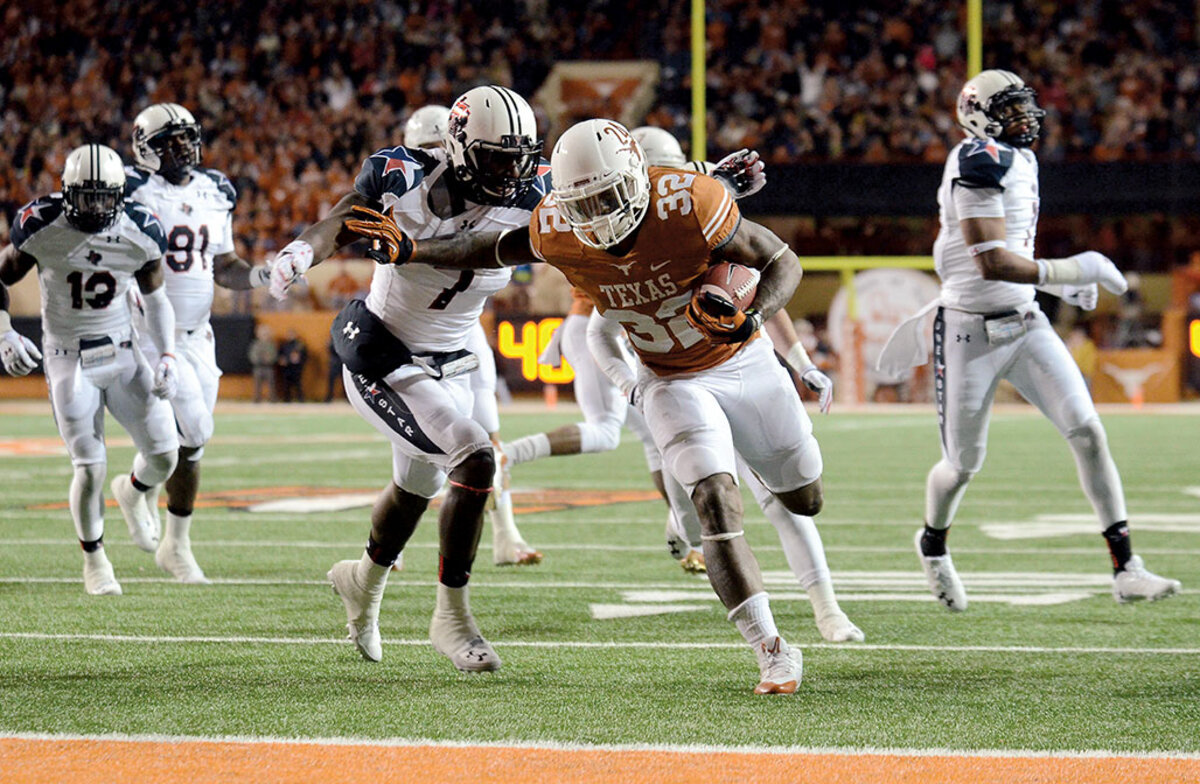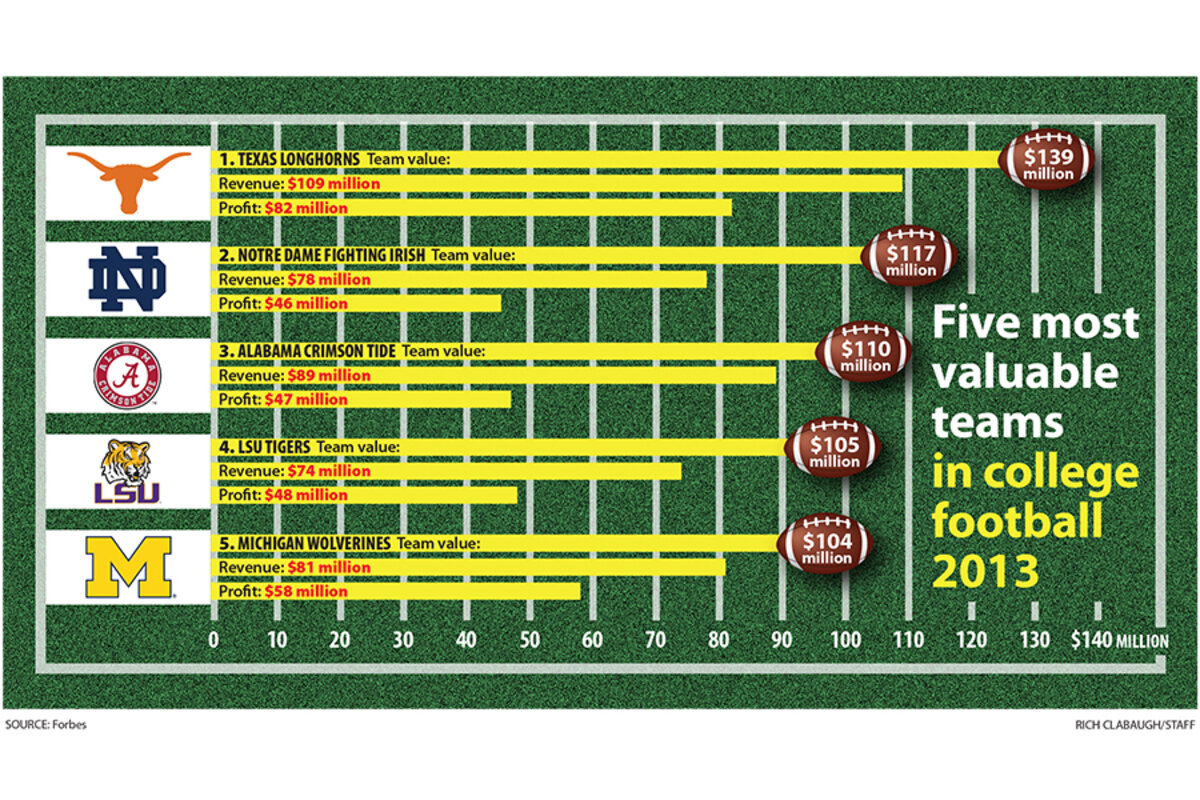NCAA and college sports: It is time to pay athletes to play?
Loading...
The historic push by football players at Northwestern University to unionize is a sign of seismic changes now sweeping through college sports. Hanging in the balance is the idea of the amateur student-athlete that has defined college sports for generations yet is under attack as an anachronistic farce.
Current and former players are turning to lawsuits to try to dismantle what they call an unfair system that generates billions of dollars yet gives them only a scholarship as compensation.
So far, the National Collegiate Athletic Association (NCAA) has tried to address concerns through a series of reforms, the biggest of which could be adopted in August and would essentially split major college football into two tiers – the haves and the have-nots. Crucially, though, amateurism would remain intact.
For that reason, the reforms are not likely to be enough, many experts say. The lawsuits and mounting pressure from Congress point to a long period of reform in which the NCAA is likely to be reshaped more deeply, they say.
Perhaps colleges will be allowed to offer more than scholarships to lure top prospects. Or top players will be able to cash in on their fame though image rights. Or perhaps major college football will be broken off from universities as a semi-independent entity with new rules. The unprecedented nature of the challenges facing the NCAA means it’s virtually impossible to predict what might come next. But many analysts believe college football and basketball will be different, and perhaps significantly so.
“We’re right on that tipping point,” says Karen Weaver, a professor at the Center for Hospitality and Sport Management at Drexel University in Philadelphia. “You’re going to see change sooner [rather] than later.”
At the core of the reform campaign is the conviction among players that they are becoming employees without adequate compensation.
Former Northwestern quarterback Kain Colter estimates that he spent as many as 60 hours a week on football-related activities during summer training camps. During the season, that fell to 40 to 50 hours a week, he said in testimony to the National Labor Relations Board (NLRB) in February.
“Everything we do is scheduled around football,” he said, suggesting that advisers warded him away from classes that might interfere with the football workload. “We’re brought to the university to play football.”
That’s why Mr. Colter led the push to unionize Northwestern’s football team. In March, a regional NLRB director granted it that right.
The ruling throws college football into uncharted waters. For the moment, it is being appealed. And Northwestern’s players might choose not to form a union. They voted on whether to organize in April, but the results will remain sealed until the national office of the NLRB affirms – or overturns – the local ruling.
What happens if teams can unionize?
Regardless of what Northwestern players do, the ruling – if upheld – is a watermark that threatens confusion and change.
For one, it affects only private universities, meaning Northwestern is the only team in the Big Ten Conference that could unionize. While college football is dominated by public universities, six of last season’s top 25 teams were private, and if players from these schools organized, they could in theory go on strike, causing chaos.
The ruling could also result in two classes of players – private-school athletes who can unionize and public-school ones who can’t. In Connecticut, state Democratic Rep. Patricia Dillon is planning to propose legislation that would guarantee similar organizing rights to players at state schools there to give them “equal footing.”
How universities might respond is equally murky. If a private university tried to negotiate with its unionized football players, it would be violating NCAA rules, which could affect funding for other sports. Because the NCAA controls scholarship money and health-care costs, universities like Northwestern would likely have limited authority to negotiate.
For these reasons, some analysts say unionization is not the best lever for change.
“When you really get into it, a football union doesn’t seem a sufficient or productive way to solve the problems of exploitation for these kids. I do think the NCAA needs to change, but it almost makes more sense if there was one giant union for all football players of all Division I schools that could negotiate en masse,” says Eldon Ham, a sports attorney and law professor at the Illinois Institute of Technology in Chicago.
But the unionization push is simply a taste of the challenges facing the NCAA, the governing body for sports programs at more than 1,200 American and Canadian universities. Two antitrust lawsuits, in particular, could radically reshape college athletics if they succeed.
The first, known as the O’Bannon case, challenges colleges’ ability to make massive television deals without any of that revenue going to players. The second, known as the Kessler case, seeks to strike down the scholarship-only system, allowing colleges to freely offer other incentives to recruits.
Underlying these lawsuits and others is players’ frustration that the NCAA is flush with the cash that they have helped generate. According to Forbes, No. 1 on the college football revenue list is the University of Texas at Austin, earning $139 million in the 2012-13 season. The University of Louisville was tops in men’s basketball, generating $40 million during the same season.
A concerned Congress has held hearings looking into the NCAA’s tax-exempt status. At a May hearing in the US House of Representatives, Rep. George Miller (D) of California said the NCAA has “perfected the art of monetizing the athletic play of their best football and basketball players and teams.”
The NCAA’s plan
The NCAA’s latest proposed reforms attempt to address some of these concerns. They would bring more Division I student-athlete and alumni voices to the table via committee positions, and, most significantly, allow the Big 5 conferences – the Atlantic Coast, Big 12, Big Ten, Pacific-12, and Southeastern – to become more independent.
One reason the NCAA hasn’t been able to do more for top athletes is that smaller colleges have opposed big changes. After all, small schools don’t face the same problems. But under the new reforms, the Big 5 conferences would have more leeway to make their own rules on issues such as scholarships, hours of practice, long-term medical coverage, academic support, and family travel benefits.
What the reforms would not budge on is the idea that college players are amateur student-athletes. A strong majority of Americans back that stance, a Monitor/TIPP poll shows. Some 59 percent of respondents say rewards for college athletes need to be strictly limited and regulated. Only 31 percent say students should be able to share the financial bonanza that is generated by college sports.
Even apart from the money question, many critics ask if a college scholarship is really a useful compensation for many players.
Mary Willingham, who tutored basketball players at the University of North Carolina at Chapel Hill, conducted a study of football and basketball players at the school from 2004 to 2012. She found that 60 percent read at fourth- to eighth-grade levels. Another 8 to 10 percent read at below third-grade levels. Some were illiterate.
“So what are the classes they are going to take to get a degree here? You cannot come here with a third-, fourth-, or fifth-grade education and get a degree here,” she told CNN, saying she did the course work for some players.
It all may amount to a potential perfect storm. Players are prohibited from sharing the money they help generate and in return are given access to an education that many don’t want, can’t cope with, or – in the case of Northwestern’s Colter – are prevented from taking full advantage of.
The NCAA has worked to improve graduation rates. The 2013 graduation success rate for Big 5 football programs was 71 percent, a historical high; for basketball, it was 73 percent, one point off a historical high. The NCAA national average is 81 percent.
But player advocates say real changes will happen only if athletes get a greater voice in decisionmaking. One group, Game Changers, wants current and former athletes to fill at least half of the NCAA’s 17-member board of directors, up from one position being proposed this summer.
“Only this kind of revision would guarantee genuine change,” Game Changers says in a report.
Visions for the future
So how would a more radically reformed NCAA look?
The semiautonomous model. Some sports management experts say universities could turn their football programs into semiautonomous enterprises that are self-supporting, much like university medical systems. In this model, college athletes would earn professional status as paid employees instead of receiving scholarships. They would attend classes only outside their respective sports seasons. The corruptive elements, such as under-the-table payments for signings, would be eliminated because players would earn competitive wages generated by media and merchandise revenue.
“It’s a vision that could work,” says Howard Nixon, a professor of sociology at Towson University in Maryland and author of “The Athletic Trap: How College Sports Corrupted the Academy.” “I am not someone who says, ‘Let’s get rid of all college sports.’ I think it can change, and this is a great opportunity.”
The academic model. At the opposite end of the spectrum, sports programs could be completely subsumed within a university’s academic system, playing down the role of the NCAA and big money. In this scenario, scholarships would be only for needs-based athletes, and the key employees associated with sports programs – coaches, trainers, academic support staff, medical staff, and so forth – would be integrated into the university hierarchy. For example, coaches might work out of student affairs. “So when you’re fundraising, you’re not targeting athletics, you’re targeting the university. These would be very scaled-down programs,” Mr. Nixon says.
Both models would represent an overhaul of the current system.
The case-by-case model. To other observers, there is a middle way that is simpler and less costly. Because the majority of complaints regarding compensation and residual benefits apply to a small share of players, the NCAA could create special rules applicable only to those who have high market worth and a brand worth exploiting.
“Most of the kids at Northwestern are getting a scholarship worth about $60,000, but most of them will never make anywhere near $60,000 playing football anywhere else. But there will be a couple who are good enough, and those guys are probably underpaid. The other kids on scholarship, those guys are probably overpaid in the sense that they’ll never make that kind of money anyway, so they are not being exploited at all,” says Professor Ham.
The issues regarding residual compensation – the rights of players to earn money from autographs or their likenesses in video games, for instance – could be addressed on a case-by-case basis, says Andrew Brandt, director for the Moorad Center for the Study of Sports Law at Villanova University and an ESPN analyst.
“I understand the notion of amateurism and all for one, one for all, but you can count the number of players on two hands that have the marketing opportunities beyond the game itself,” Mr. Brandt says. “The NCAA could allow them to capitalize on that while still controlling what it wants to control.”
The most forceful voices may come from parents and faculty who face soaring tuition hikes, departmental budget cuts, and other shortages at the same universities where athletic revenues are at a surplus. To them, the millions of dollars football teams like the Northwestern Wildcats earn are not necessarily helping to bring down costs or boost resources.
“For a long time the NCAA has avoided having to deal with the fact that it is a highly commercialized business that generates a lot of revenue yet is treated as other nonprofit businesses,” Nixon says. “If these schools keep raising tuition, when are people going to say ‘You’re putting our kids into debt to support athletics’? Part of this is about the money, but it’s also about fairness and ending the exploitation of student-athletes for everybody else’s gain.”






